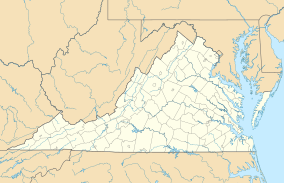The Cape Henry Memorial commemorates the first landfall at Cape Henry, in Virginia Beach, Virginia, of colonists bound for the Jamestown settlement. After landing on April 26, 1607, they explored the area, named the cape, and set up a cross before proceeding up the James River. A stone cross, set up in 1935 by the Daughters of the American Colonists, stands in the quarter-acre site. The memorial marks the First Landing, the very beginning of what would become British North America and subsequently Anglo Canada and the United States of America.
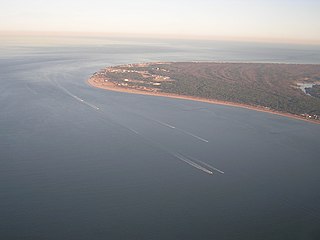
Cape Henry is a cape on the Atlantic shore of Virginia located in the northeast corner of Virginia Beach. It is the southern boundary of the entrance to the long estuary of the Chesapeake Bay.

Virginia Beach is an independent city located on the southeastern coast of the Commonwealth of Virginia in the United States. As of the 2010 census, the population was 437,994. In 2015, the population was estimated to be 452,745. In 2017 the estimated population was 450,435. Although mostly suburban in character, it is the most populous city in Virginia and the 41st most populous city in the nation. Located on the Atlantic Ocean at the mouth of the Chesapeake Bay, Virginia Beach is included in the Hampton Roads metropolitan area. This area, known as "America's First Region", also includes the independent cities of Chesapeake, Hampton, Newport News, Norfolk, Portsmouth, and Suffolk, as well as other smaller cities, counties, and towns of Hampton Roads.

The Jamestown settlement in the Colony of Virginia was the first permanent English settlement in the Americas. It was located on the east bank of the James (Powhatan) River about 2.5 mi (4 km) southwest of the center of modern Williamsburg. William Kelso writes that Jamestown "is where the British Empire began". It was established by the Virginia Company of London as "James Fort" on May 4, 1607 O.S.;(May 14, 1607 N.S.), and was considered permanent after brief abandonment in 1610. It followed several failed attempts, including the Lost Colony of Roanoke, established in 1585 on Roanoke Island. Jamestown served as the capital of the colony of Virginia for 83 years, from 1616 until 1699.
The Memorial also overlooks the scene of the Battle of the Virginia Capes, in which the French navy prevented the British from reinforcing General Cornwallis, and led to the Franco-American victory at Yorktown. A statue of Admiral Comte de Grasse and a granite memorial honor those who fought in the battle.
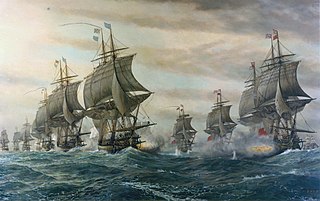
The Battle of the Chesapeake, also known as the Battle of the Virginia Capes or simply the Battle of the Capes, was a crucial naval battle in the American Revolutionary War that took place near the mouth of the Chesapeake Bay on 5 September 1781. The combatants were a British fleet led by Rear Admiral Sir Thomas Graves and a French fleet led by Rear Admiral Francois Joseph Paul, the Comte de Grasse. The battle was strategically decisive, in that it prevented the Royal Navy from reinforcing or evacuating the besieged forces of Lieutenant General Lord Cornwallis at Yorktown, Virginia. The French were able to achieve control of the sea lanes against the British and provided the Franco-American army with siege artillery and French reinforcements. These proved decisive in the Siege of Yorktown, effectively securing independence for the Thirteen Colonies.
Although not memorialized at the park, this was also the location of the earlier smaller naval Battle of Cape Henry in which British and French naval squadrons fought in 1781.

The Battle of Cape Henry was a naval battle in the American War of Independence which took place near the mouth of Chesapeake Bay on 16 March 1781 between a British squadron led by Vice Admiral Mariot Arbuthnot and a French fleet under Admiral Charles René Dominique Sochet, Chevalier Destouches. Destouches, based in Newport, Rhode Island, had sailed for the Chesapeake as part of a joint operation with the Continental Army to oppose the British army of Brigadier General Benedict Arnold that was active in Virginia.
The Cape Henry Memorial is within Joint Expeditionary Base East, but is an isolated unit of Colonial National Historical Park. A national park passport stamp for the Memorial can be obtained at the adjacent Old Cape Henry Light (not formally part of the Memorial).

Colonial National Historical Park is located in the Hampton Roads region of Virginia and is operated by the National Park Service of the United States government. The park protects and interprets several sites relating to the Colony of Virginia and the history of the United States more broadly, ranging from the site of the first landing of the English settlers who would settle at Jamestown, to the battlefields of Yorktown where the British Army was finally defeated in the American Revolutionary War. Over 3 million people visit the park each year.

Jamestown Settlement is a living history museum operated by the Commonwealth of Virginia, created in 1957 as Jamestown Festival Park for the 350th anniversary celebration. Today it includes a recreation of the original James Fort, a Powhatan Indian Village, indoor and outdoor displays, and replicas of the original settlers' ships the Susan Constant, Godspeed, and Discovery.
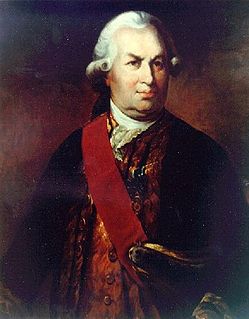
François Joseph Paul, comte de Grasse was a career French officer who achieved the rank of admiral. He is best known for his command of the French fleet at the Battle of the Chesapeake in 1781 in the last year of the American Revolutionary War. It led directly to the British surrender at Yorktown and helped gain the rebels' victory.

The York River is a navigable estuary, approximately 34 miles (55 km) long, in eastern Virginia in the United States. It ranges in width from 1 mile (1.6 km) at its head to 2.5 miles (4.0 km) near its mouth on the west side of Chesapeake Bay. Its watershed drains an area of the coastal plain of Virginia north and east of Richmond.

The Battle of Baltimore was a sea/land battle fought between British invaders and American defenders in the War of 1812. American forces repulsed sea and land invasions off the busy port city of Baltimore, Maryland, and killed the commander of the invading British forces. The British and Americans first met at North Point. Though the Americans retreated, the battle was a successful delaying action that inflicted heavy casualties on the British, halting their advance consequently allowing the defenders at Baltimore to properly prepare for an attack.

The First Battle of Cape Finisterre saw 14 British ships of the line under Admiral George Anson attack a French 30-ship convoy commanded by Admiral de la Jonquière during the War of the Austrian Succession. The British captured 4 ships of the line, 2 frigates and 7 merchantmen, in a five-hour battle in the Atlantic Ocean off Cape Finisterre in northwest Spain. One French frigate, one French East India Company warship and the other merchantmen escaped.

The Cape Henry Lighthouse is a lighthouse at Cape Henry, the landform marking the southern entrance to Chesapeake Bay in the U.S. state of Virginia. The location has long been important for the large amount of ocean-going shipping traffic for the harbors, its rivers, and shipping headed to ports on the bay. The original lighthouse was the first authorized by the U.S. government, dating from 1792. It was also the first federal construction project under the Constitution, for an original contract amount of $15,200. A second lighthouse was built and completed in 1881 a short distance away after concern arose about the stability of the first. Both towers of the light station were designated a National Historic Landmark in 1970.

First Landing State Park offers recreational opportunities at Cape Henry in the independent city of Virginia Beach, Virginia. As the first planned state park of Virginia, First Landing is listed on the National Register of Historic Places as Seashore State Park Historic District. A portion of the park is listed as a National Natural Landmark as part of the Seashore Natural Area.

The Yorktown or Virginia campaign was a series of military maneuvers and battles during the American Revolutionary War that culminated in the decisive Siege of Yorktown in October 1781. The result of the campaign was the surrender of the British Army force of General Charles Earl Cornwallis, an event that led directly to the beginning of serious peace negotiations and the eventual end of the war. The campaign was marked by disagreements, indecision, and miscommunication on the part of British leaders, and by a remarkable set of cooperative decisions, at times in violation of orders, by the French and Americans.
Virginia Beach, Virginia is a city that has become a popular tourist destination in recent years on account of its historical, scientific, and performing arts.

Lone Pine Cemetery is a Commonwealth War Graves Commission cemetery dating from World War I in the former Anzac sector of the Gallipoli Peninsula, Turkey and the location of the Lone Pine Memorial, one of five memorials on the peninsula which commemorate servicemen of the former British Empire killed in the campaign but who have no known grave.

The Action of 21 July 1781 was a naval skirmish off the harbor of Spanish River, Cape Breton, Nova Scotia, during the American Revolution. Two French Navy frigates, led by Admiral Latouche Tréville and La Pérouse, engaged a convoy of 18 British ships and their escorts from the Royal Navy. The two French frigates captured two of the British escorts while the remainder of the British convoy escaped.

The Battle of Turtle Gut Inlet was an important, early naval victory for the Continental Navy and the future "Father of the American Navy", Captain John Barry. It was the first privateer battle of the American Revolutionary War. The battle resulted in the first American casualty of the war in New Jersey, Lieutenant Richard Wickes, brother of Captain Lambert Wickes. It was the only Revolutionary War battle fought in Cape May County.

The Helles Memorial is a Commonwealth War Graves Commission war memorial near Sedd el Bahr, in Turkey, on the headland at the tip of the Gallipoli peninsula overlooking the Dardanelles. It includes an obelisk which is over 30 metres (98 ft) high.
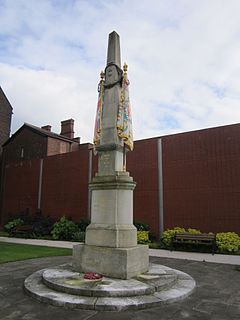
The Lancashire Fusiliers War Memorial is a First World War memorial dedicated to members of the Lancashire Fusiliers killed in that conflict. Outside the Fusilier Museum in Bury, Greater Manchester, in North West England, it was unveiled in 1922—on the seventh anniversary of the landing at Cape Helles, part of the Gallipoli Campaign in which the regiment suffered particularly heavy casualties. The memorial was designed by Sir Edwin Lutyens. Lutyens was commissioned in light of a family connection—his father and great uncle were officers in the Lancashire Fusiliers, a fact noted on a plaque nearby. He designed a tall, slender obelisk in Portland stone. The regiment's cap badge is carved near the top on the front and rear, surrounded by a laurel wreath. Further down are inscriptions containing the regiment's motto and a dedication. Two painted stone flags hang from the sides.
This page is based on this
Wikipedia article Text is available under the
CC BY-SA 4.0 license; additional terms may apply.
Images, videos and audio are available under their respective licenses.







